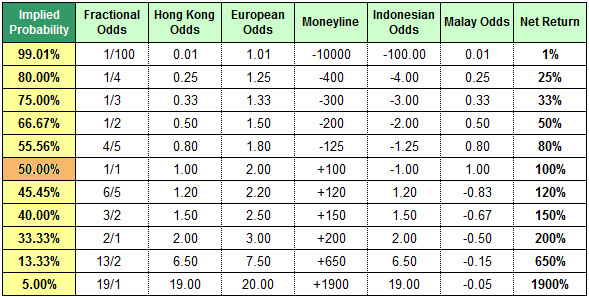Odds Converter To Money

For example, when you use an odds converter to convert decimal 1.33 you get 1/3 fractional and -300 american but if you convert 1/3 to american you might see -303.03. While this conversion to -303.03 is actually correct, some bookies tend to refer to -300 when meaning the fractional 1/3 because it's easier for the punter to remember, while. 00:00 EST Money Spread Over/Under; Santa Clara +155 +4(-110) O 150.5(-110) Pepperdine-175-4(-110) U 150.5(-110).
Use the tool below to convert odds between American, decimal, fractional and percentage formats.
Betting Odds Explained
American Odds – American Odds are the default odds format at most US friendly betting sites as well as Nevada sports books. Here odds are expressed as either a negative or a positive number. When positive the odds represent how much a player will profit on a successful $100.00 wager. So for example if the odds are +180 a successful $100 bet will return $280 (the $100 stake + $180.00 win). When the odds are negative they represent how much a bettor must stake to win $100. Therefore $150 staked at -150 returns $250.00 (the $150 stake + $100 win).
Decimal Odds – Decimal Odds, also referred to as European Odds, are used in most European countries and are the default option of many Asian bookies as well. This is the easiest odds format to understand as the odds represent how much a 1 unit wager returns. For example a €1 wager at odds 1.91 returns €1.91. This return includes both your stake plus profit; to calculate how much your return will be simply multiple your stake by the given odds.
Fractional Odds – Fractional Odds are used in the UK and Ireland. Here the first number is the amount to be won, and the second number is the stake. So for examples 4/1 is stake 1 to win 4, and 10/11 is stake 11 to win 10. To calculate how much a winning bet will profit, convert the fraction to a decimal and multiply it by the stake. For example 3/2=1.5, so, if wagering at 3/2 a successful bet will return 1.5 times your stake in winnings and will also return your stake.
Implied Probability – Implied Probability is how often a bet must win to average break even. This is calculated as risk/return, so for example +200 in American format (3.00 European) is risk $100 to win $200 so a winning wager returns $300 ($100 stake + $200 win). Therefore the implied probability of +200 is $100/$300= 0.3333, which is 33.33%. For this reason you should only wager at +200 if you think the probability of winning is greater than 33.33%.
On the topic of odds, refer to our No-Vig Calculator for a better understanding of how betting odds work.

Implied probability is basically the conversion of odds into a percentage. That percentage then shows the likelihood of an outcome happening based on the size of the odds. High odds suggest a low probability of something happening, while low odds suggest a high probability of something happening.

For example, imagine a tennis player is +200 to win an upcoming match. This would be 3.00 in decimal odds, and 2/1 in fractional odds. The implied probability for these odds is 33.33%. In this example, the odds suggest that the player has a 33.33% chance of winning the match.
In sports, the probability of something happening is usually subjective. There are several factors to take into account and there’s always a chance of the unexpected. No one can state definitively the exact probability of a player or team winning a game they’re taking part in. There’s an element of personal opinion involved.


Calculating the implied probability is useful though. It helps us decide whether or not we think a bet offers any positive value. We should always look for positive value when betting, and it exists when our estimated probability of an outcome happening is greater than the implied probability that the odds on that outcome suggest.
Odds Converter To Money Transfer
Confused? Don’t worry! It’s not as complicated as it may seem. To make this easier to understand, let’s continue with the example of the tennis player at +200 to win his match. As we’ve said, the implied probability here is 33.33%. So if we think that the player has a GREATER than 33.33% of winning, then it makes perfect sense to bet on him. If we think his chances are less than 33.33%, it’s wise not to bet on him.
Odds Converter To Money Calculator
If you’d like a more complete explanation on this subject, there’s an article in our sports betting guide that explains value and implied probability in further detail.